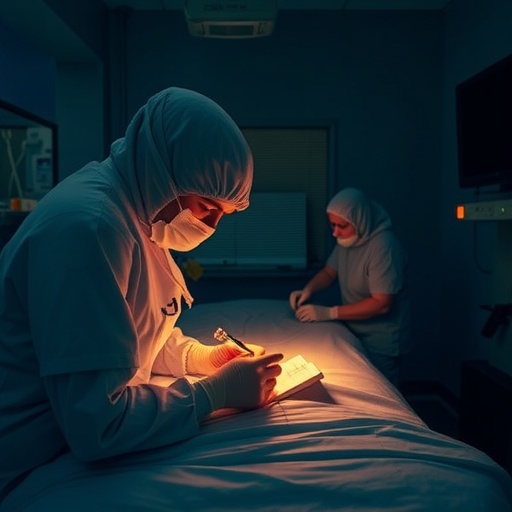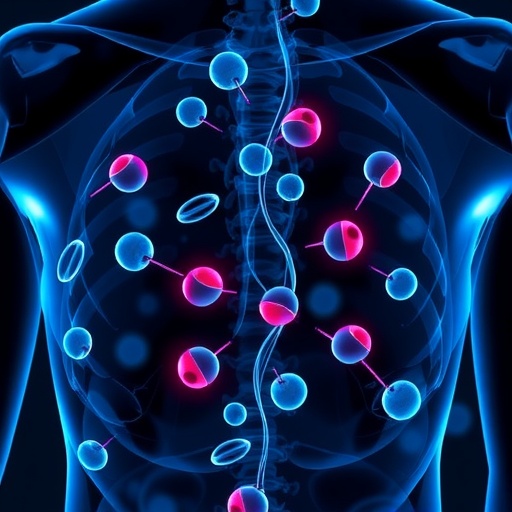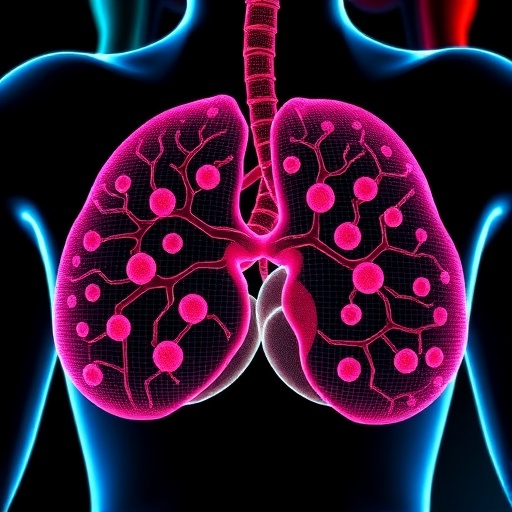
In an era where migration shapes demographics, cultures, and geopolitics worldwide, the human stories behind these movements often remain obscured or oversimplified. However, a groundbreaking study published in the International Journal of Legal Medicine sheds new light on migration through an interdisciplinary technique that melds forensic medicine with medico-legal narrative analysis. This innovative approach provides a nuanced understanding of asylum seekers’ lived experiences, unveiling layers of trauma, resilience, and systemic interaction that conventional methods often fail to capture.
The study, led by experts including J. Moffat, S. Tambuzzi, and L. Franceschetti, explores how forensic evidence combined with detailed medico-legal accounts can map the intricate and evolving pathways of migrants over time. This method extends beyond the traditional framework of legal medicine, positioning it as a vital tool for human rights advocacy and policy formulation. Their research underscores the profound value that forensic medicine holds not merely in diagnosis or physical documentation, but as a repository of social, psychological, and legal insights pivotal to asylum processes.
Forensic medicine, often associated with criminal investigations or accident assessments, assumes a powerful new role within this context. The clinical and biological data derived from medical examinations and analysis of injury patterns offer concrete, empirical evidence supporting the veracity of asylum claims. When combined with personal narratives and medico-legal statements, these forensic findings establish a multidimensional verification matrix that enhances the credibility and comprehensiveness of legal testimonies. This fusion represents a significant paradigm shift in how asylum applications are scrutinized and substantiated.
.adsslot_re7YBQtCKp{width:728px !important;height:90px !important;}
@media(max-width:1199px){ .adsslot_re7YBQtCKp{width:468px !important;height:60px !important;}
}
@media(max-width:767px){ .adsslot_re7YBQtCKp{width:320px !important;height:50px !important;}
}
ADVERTISEMENT
One of the most compelling aspects of this research is its temporal dimension. Instead of capturing isolated snapshots, the study tracks the evolution of forensic and narrative evidence longitudinally. This dynamic examination acknowledges that migrant experiences are not static but continuously shaped by their environments, encounters, and ongoing vulnerabilities. As migrants navigate perilous journeys and uncertain asylum procedures, forensic medicine documents changing physical and psychological states, thereby reflecting the lived reality of displacement in extraordinary detail.
The implications extend deeply into the realm of humanitarian protection. Often, asylum seekers’ testimonies face skepticism or are rejected due to insufficient proof or perceived inconsistencies. By integrating forensic medical evidence with comprehensive personal accounts, legal authorities gain a more robust framework for assessing authenticity. This integration can significantly reduce wrongful rejections and protect vulnerable individuals who have endured torture, violence, or persecution, whose injuries might otherwise go unrecognized or inadequately documented.
Beyond individual cases, the research highlights the broader societal and systemic conditions that impact migrants. Through the forensic lens, the study reveals patterns of abuse and neglect across different geographies and timeframes, identifying recurring themes such as physical trauma consistent with torture, malnutrition, or hazardous journeys. Moreover, medico-legal narratives often provide intimate portraits of psychological suffering, including symptoms of post-traumatic stress and depression, thereby framing migration as not just a legal problem but a profound public health and human rights challenge.
Technically, the methodology employed is highly sophisticated. Utilization of diverse forensic tools—ranging from soft tissue injury analysis and radiological imaging to toxicology and histopathological examinations—enables precise documentation of physical harm. Concurrently, narrative assessments conducted by forensic experts trained in psychological evaluation decode the embedded trauma markers within asylum seekers’ stories, facilitating a holistic appraisal. This two-pronged strategy underscores innovation in forensic practice by expanding its utility into the socio-legal dimensions of migration.
The integration of forensic evidence into asylum procedures also necessitates ethical rigor and interdisciplinary collaboration. Experts involved must navigate complex issues of consent, confidentiality, and cultural sensitivity while maintaining technical accuracy and impartiality. The study reinforces the importance of training forensic practitioners not only in technical aspects but also in the nuances of intercultural communication and human rights law, forming a multidisciplinary hub that bridges medicine, law, and social justice.
This research arrives at a critical historical juncture. Global displacement has reached unprecedented levels due to climate crises, political instability, and economic disparity. Traditional asylum systems are overwhelmed, and misinformation proliferates, fomenting xenophobia and policy paralysis. The forensic-medicolegal framework presented offers an evidence-based counter-narrative, empowering adjudicators and policymakers with credible, granular data that honors the complexity and dignity of each migrant’s journey.
Importantly, the study illuminates the evolving role of technology in forensic documentation. Digital imaging, three-dimensional reconstruction, and biometric analysis enhance precision and enable remote consultations or cross-border verification processes. These advancements support a more transparent and efficient asylum adjudication process, reducing reliance on subjective interpretations and fostering trust between applicants and authorities. The interplay between cutting-edge science and humanitarian imperatives demonstrates the field’s adaptive potential in contemporary global challenges.
Moreover, the research addresses the psychological dimension extensively. Migrants often suffer “invisible wounds” that elude conventional medical examination yet leave pervasive marks on their wellbeing and testimony coherence. Forensic experts who incorporate psychological autopsy techniques and trauma-informed interviewing are better equipped to detect and validate these harms. Through this, forensic medicine transcends its conventional boundaries, becoming an agent of empathy as well as evidence.
Policy implications flow naturally from these findings. The enhanced evidentiary framework can reshape asylum adjudication standards, influencing international human rights protocols and national legislations. Adoption of this integrated approach could standardize more humane and scientifically sound evaluations, ultimately promoting justice and equity within migration systems. Furthermore, this model creates a foundation for training programs, judicial reforms, and international cooperation focused on protecting migrant rights through rigorous evidence.
This seminal study also prompts a reflection on the intersection between forensic medicine and social advocacy. By documenting abuses and validating experiences, forensic examinations become not just a diagnostic tool but an instrument for social change and accountability. They can support litigation efforts against perpetrators of violence or neglect, and serve as a platform amplifying migrants’ voices within often-hostile public discourses and political arenas.
Challenges undoubtedly remain. The resource-intensive nature of forensic examinations and the need for widespread expert availability pose logistical barriers. Ethical dilemmas surrounding intrusive procedures and balancing objectivity with compassion call for ongoing dialogue and methodological refinement. Nonetheless, the promise of this integrated forensic-medico-legal approach is irrefutable, illuminating pathways toward a more just recognition of migrant experiences globally.
In an age where empirical validation and human empathy often seem opposed, this research bridges the gap ingeniously. It delivers a scientifically rigorous yet profoundly human perspective on migration, offering tools that empower stakeholders to perceive asylum seekers as complex individuals with uniquely inscribed histories written on their bodies and stories. This represents an urgent and transformative advancement at the frontier of forensic science and humanitarian law.
By embracing this sophisticated analytic prism, the forensic community may transform the stagnant processes of migration adjudication, replacing them with dynamic frameworks responsive to the nuances of human suffering and legal responsibility. This paradigm interlocks the personal and the procedural, the scientific and the ethical, fostering a future where migration narratives are not merely heard but validated and respected with the full weight of medical and forensic expertise.
Ultimately, this path-breaking study marks a watershed moment, showcasing forensic medicine’s multifaceted utility as a linchpin in uncovering migrants’ truths. It illuminates the pathway to more just, empathetic, and scientifically grounded migration systems worldwide—where medico-legal narratives and forensic evidence collectively tell the stories that matter the most in an increasingly mobile and vulnerable world.
Subject of Research:
The multifaceted utility of forensic medicine and medico-legal narratives in documenting and analyzing asylum applicants’ experiences over time.
Article Title:
The migrant experience through the lens of forensic medicine: the multifaceted utility of asylum applicants’ medico-legal narratives and forensic evidence analysed over time.
Article References:
Moffat, J., Tambuzzi, S., Franceschetti, L. et al. The migrant experience through the lens of forensic medicine: the multifaceted utility of asylum applicants’ medico-legal narratives and forensic evidence analysed over time. Int J Legal Med (2025). https://doi.org/10.1007/s00414-025-03531-0
Image Credits: AI Generated
Tags: asylum seekers lived experiencesempirical evidence in human rightsforensic medicine in migration studieshistorical narratives of migrant journeyshuman rights advocacy in asylum processesinnovative research in legal medicineinterdisciplinary approaches to migrationlegal implications of forensic evidencemedico-legal narrative analysismigration demographics and geopoliticssystemic interactions in asylum casestrauma and resilience in migration





